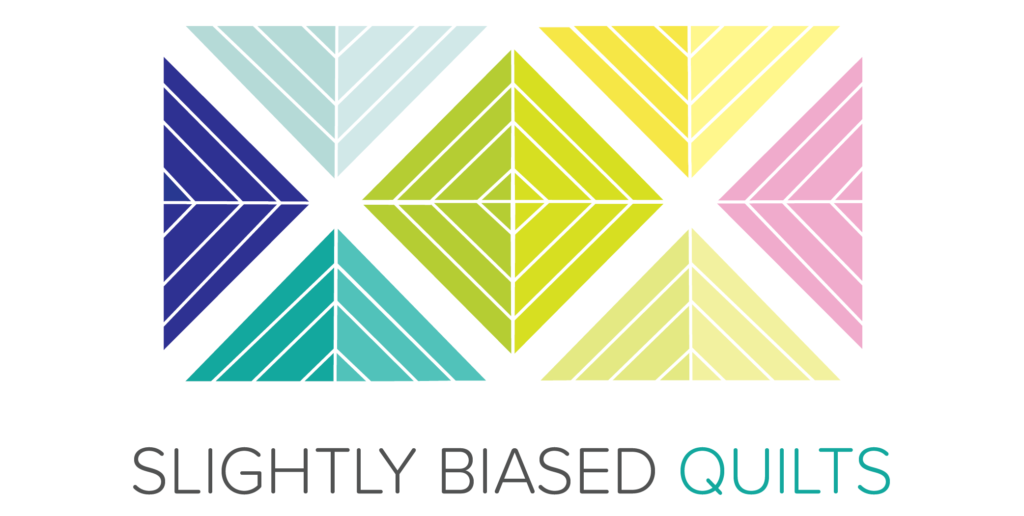Update: I now have a handy printable for all your binding needs! Find it here in my shop!
Hi everyone! Happy Friday! Today I’m pleased to be a part of the Back to School Blog Hop 2022! Bobbie at The Geeky Bobbin has run a wonderful blog hop, and I’m so excited to be a part of it! Please go visit all the other posts as well:

Today I’m going to talk about hand binding your quilts. How you bind quilts is such a personal preference! I’ve tried to do a few by machine, but it never seems to turn out the way I want it to, so time after time I go back to hand stitching the binding to the top. I have a bit of a history with hand stitching (I’ve done cross-stitch for going on 30 years now), so I find it relaxing and a nice thing to do when sitting in front of the TV. If it’s not for you, that is perfectly ok!
Before we get started, you’ll need to make your binding and apply it to the front of your quilt.

Once you have your binding sewn down to the front, and you’ve decided you’re up for hand binding, you’ll need some tools nearby. I have a small sewing kit that I pull out when I get to this stage. The most important tools will be your needle, thread (to match your binding or your backing), clips, and scissors. I am quite happy with the sewing kit that I put together using Robot Mom Sews’ pattern found here. It works well for EPP (English Paper Piecing) too!


Now that you have your kit ready to go, you’ll want to start by threading your needle, knotting the end, and trimming off the excess after the knot. Enter the backing from a place that will be hidden by the binding, and exit the backing around where the binding will hit it.

Now you are ready to get started! Add your clips to keep the binding down as you go. I like to do a full enter and exit of both the binding and backing at once, like so:

It’s important to make sure you don’t go all the way through the quilt to the front, otherwise you’ll see your stitches on the front. After a little stitching, you’ll get a feel for how far to go in, and it’s good to take a peek at the front every once in a while just in case. Repeat until your thread gets short. To end the piece of thread, exit in a place that will be hidden by the binding on your next go-round, and make a few small knots to secure it.

When you come to a corner, I like to stitch it down all the way to make sure it doesn’t get caught on anything. This keeps the miter nice and clean too! To do this, first stitch all the way to the end of the quilt, before you miter your corner:

Then put your needle through where the mitered corner will end up being. It’s ok if it’s not perfect! Just try to get it somewhat close.

Then clip down the corner with with your clip, and make invisible stitches down the mitered corner. This may be difficult with the bulk in the corner, but just do your best! From there you can continue on as normal.

When you come to the very end, I secure my thread with a couple of small knots right along the edge of the binding and trim off the excess.

Hard to see, right? :) If you snuggle that knot right along the edge, no one will know where it is!
Congratulations, you’ve completed your hand binding of your quilt! I hope these tips were helpful. My biggest tip is definitely not to sweat the process. As with any skill in quilting, it will get easier as you go, and even after all these years, my bindings are never 100% perfect. Just try to enjoy the process and have fun!

I love the last moments I get with a quilt when I’m doing hand binding. Great photos and description of your process, thank you for the tutorial!
Thanks Yvonne! It’s my favorite part too.
Thank you, I struggle with the binding of my quilts. Being a beginner is a good reason for me not getting the quilt the way I want the quilt binding to look. Thank you for your help.
You’re so welcome!
I feel the same way about machine binding, but I really don’t like binding at all. The part you showed is what I don’t mind doing, but I picked up a couple of tips, thanks! What I really hate is sewing the binding on. I’m fine until I have to join the ends, and it never comes out easy, no matter whose tutorial I’m following. LOL
It definitely can be tricky joining the ends! If I think about it too hard, I get it twisted.
Thanks, I learned some new tips since hand sewing binding is my preference.
I do find it relaxing. Do you always use double thread?
Thanks again
No, I use a single thread actually!